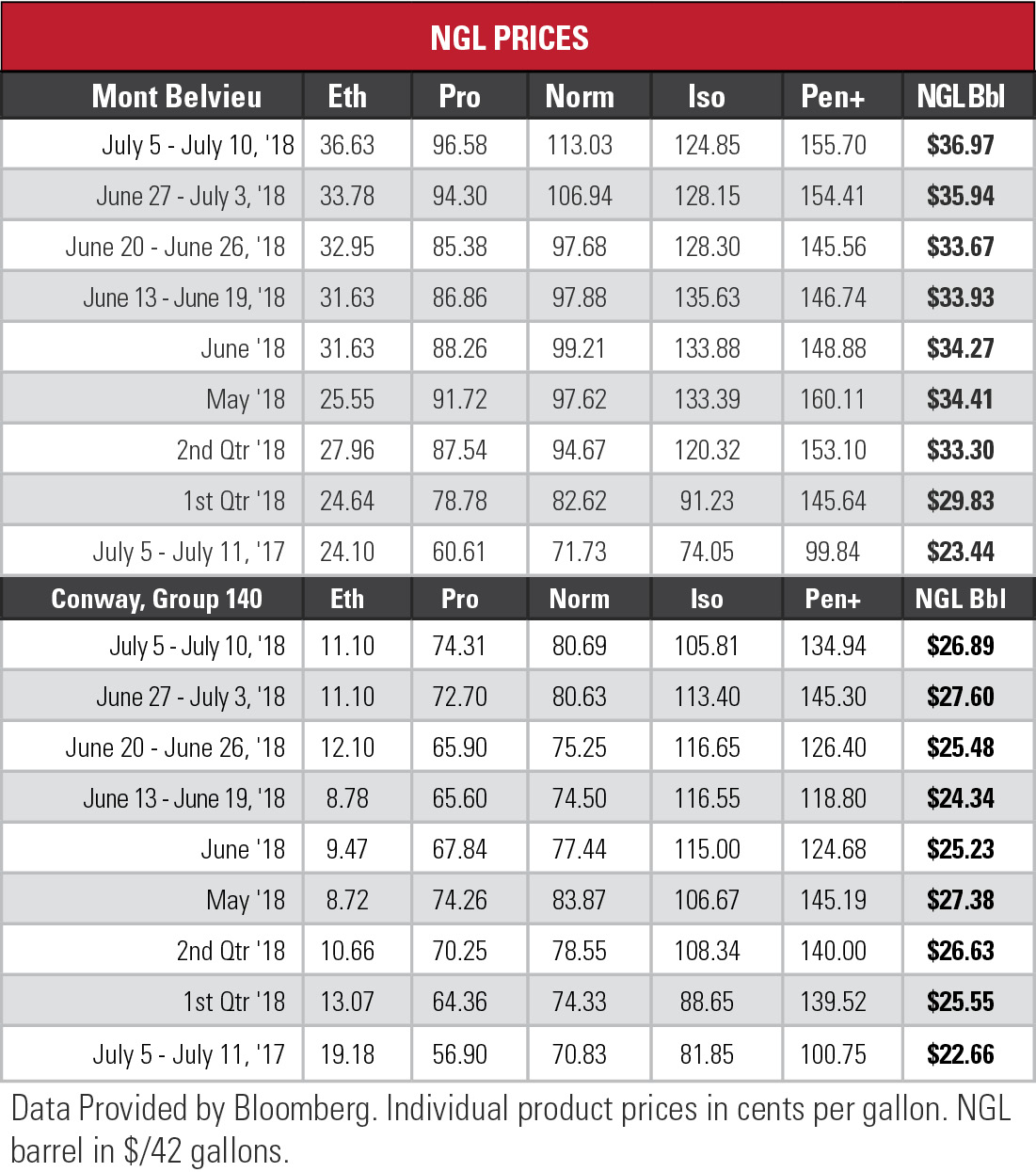
Ethane shot past 36 cents per gallon (gal)—an 8.4% jump—last week at Mont Belvieu, Texas, to accompany a 23.91% widening of its margin to almost 18 cents/gal.
It is now up 74% for the year in price and 521% (yes, 521%) in margin. Not bad if you like that sort of thing.
 The near-term outlook is promising. U.S. domestic consumption is on track to increase by 55% from 2014 to 2019, the U.S. Department of Energy (DOE) calculated in a June report. Almost all domestic output is dedicated as a feedstock for petrochemical plants that manufacture ethylene. A slew of new ethylene plant projects will increase U.S. capacity to nearly 600,000 bbl/d by year-end 2019.
The near-term outlook is promising. U.S. domestic consumption is on track to increase by 55% from 2014 to 2019, the U.S. Department of Energy (DOE) calculated in a June report. Almost all domestic output is dedicated as a feedstock for petrochemical plants that manufacture ethylene. A slew of new ethylene plant projects will increase U.S. capacity to nearly 600,000 bbl/d by year-end 2019.
Those new plants will support an export market that is a significant driver of the sector’s growth. Switching from net importer to net exporter of ethane for the U.S. happened as recently as 2014 with the start-up of two pipelines to Canada from North Dakota and Pennsylvania. Average ethane net exports, which were about 60,000 barrels per day (bbl/d) in 2015, are expected to climb as high as 350,000 bbl/d in 2019.
 The list of operators building these plants reflects global demand for U.S. ethane:
The list of operators building these plants reflects global demand for U.S. ethane:
- Taiwan-based Formosa Plastics Corp.’s Point Comfort, Texas, plant is expected to come online in 2019;
- Bangkok, Thailand-based Indorama Ventures is expected to restart its Carlyss cracker in Louisiana;
- Tokyo-based Shin-Etsu Chemical Co. Ltd. plans to start up its cracker in Louisiana this year; and
- Sandton, South Africa-based Sasol Ltd. is expected to complete its Louisiana cracker in 2020
Just as important are the projects underway abroad to receive U.S. ethane. Indian refining giant Reliance Industries has built an import terminal and ethane pipeline and has placed orders with Samsung Heavy Industries for six very large ethane carriers. The ships, capable of carrying 87,000 cubic meters of liquefied ethane, cost about $120 million each. The first was delivered in 2016.
New tankers are being specifically designed to move ethane from the Marcus Hook, Pa., export terminal to INEOS petrochemical plants in Scotland and Norway. Marcus Hook will also be the origination point for shipments to the Borealis Group’s plant in Stenungsund, Sweden. Those shipments are expected to begin in the middle of 2018. Borealis and Total have created a joint venture to build a $1.7 billion ethane steam cracker in Port Arthur, Texas.
Singapore-based SP Chemicals has modified its petrochemical cracker in China’s Jiangsu province to handle U.S. ethane. The U.S. Energy Information Administration (EIA) anticipates exports from the project to China will begin in fourth-quarter 2019.
 China Energy signed a memorandum of understanding with the state of West Virginia in 2017 to fund an $84 billion project to build multiple NGL facilities. However, recent tariff threats toward China by the Trump administration may have dampened Chinese enthusiasm for that investment.
China Energy signed a memorandum of understanding with the state of West Virginia in 2017 to fund an $84 billion project to build multiple NGL facilities. However, recent tariff threats toward China by the Trump administration may have dampened Chinese enthusiasm for that investment.
The first series of projects were expected to be announced in June at a conference in Pittsburgh, NPR reported. Chinese executives, though, declined to show up.
In the week ended July 6, storage of natural gas in the Lower 48 experienced an increase of 51 billion cubic feet (Bcf) the EIA reported, compared to the Bloomberg consensus forecast of 53 Bcf and the five-year average of 77 Bcf. The figure resulted in a total of 2.203 trillion cubic feet (Tcf). That is 24.8% below the 2.928 Tcf figure at the same time in 2017 and 19.1% below the five-year average of 2.722 Tcf.
Joseph Markman can be reached at jmarkman@hartenergy.com and @JHMarkman.
Recommended Reading
What's Affecting Oil Prices This Week? (Nov. 11, 2024)
2024-11-12 - The return of Donald Trump to the U.S. presidency could have both positive and negative impacts on the oil market.
LNG, Crude Markets and Tariffs Muddy Analysts’ 2025 Outlooks
2024-12-12 - Energy demand is forecast to grow as data centers gobble up more electricity and LNG liquefaction capacity comes online in North America, but gasoline demand may peak by 2025, analysts say.
Analysts: Trump’s Policies Could Bring LNG ‘Golden Era’ or Glut
2024-11-27 - Rystad warns that too many new LNG facilities could spell a glut for export markets.
North American LNG Exports Surge: Texas Fuels Mexico’s Growth
2024-11-05 - Mexico is finally getting its feet off the ground with LNG exports, joining the U.S. to make North America an LNG exporting powerhouse.
Mexico Pacific’s Saguaro: LNG’s Quicker Route to Asian Markets
2024-11-19 - Mexico Pacific’s 30-mtpa Saguaro LNG terminal promises a connection to Asia for Permian Gas that avoids the Panama Canal.
Comments
Add new comment
This conversation is moderated according to Hart Energy community rules. Please read the rules before joining the discussion. If you’re experiencing any technical problems, please contact our customer care team.






